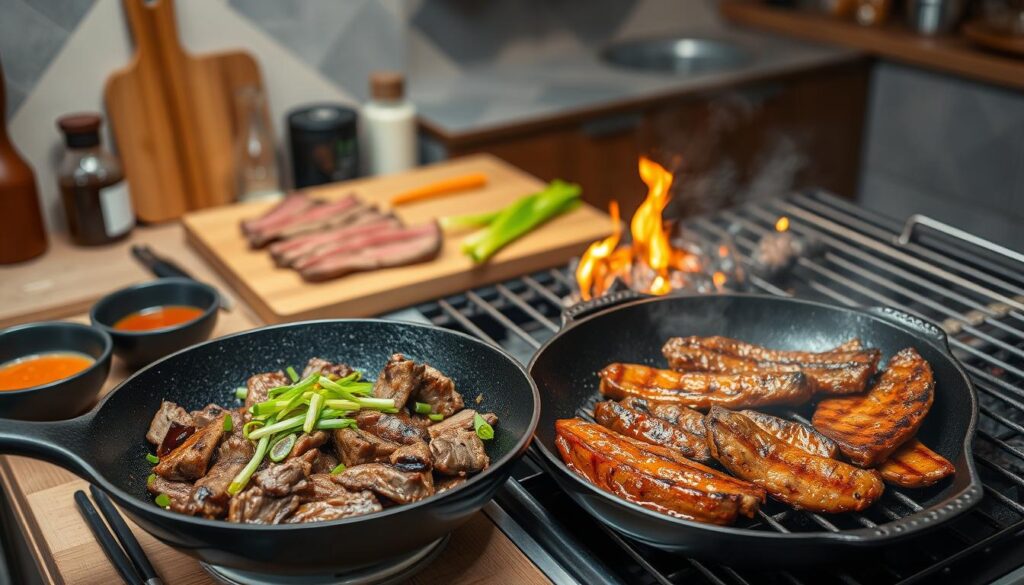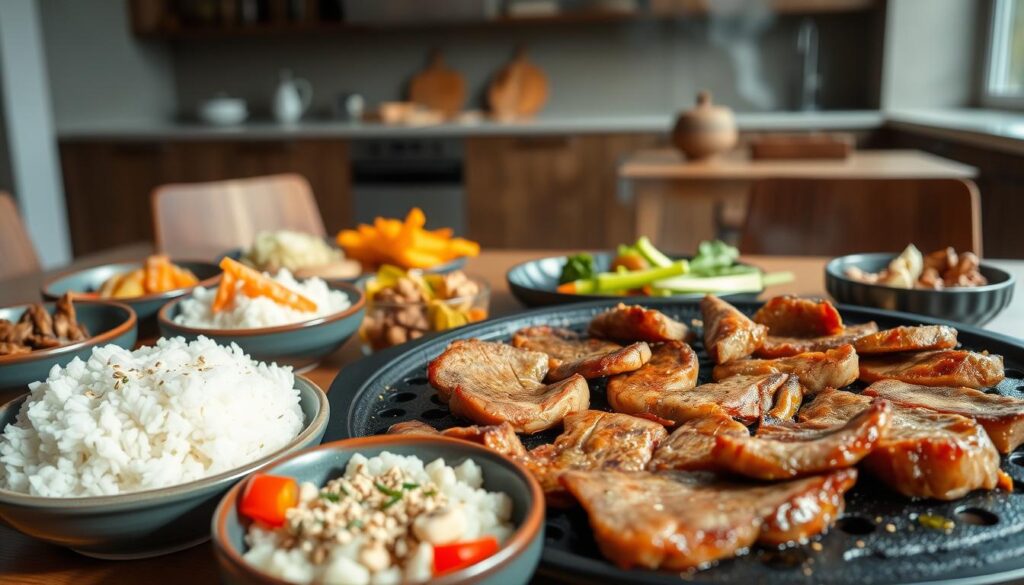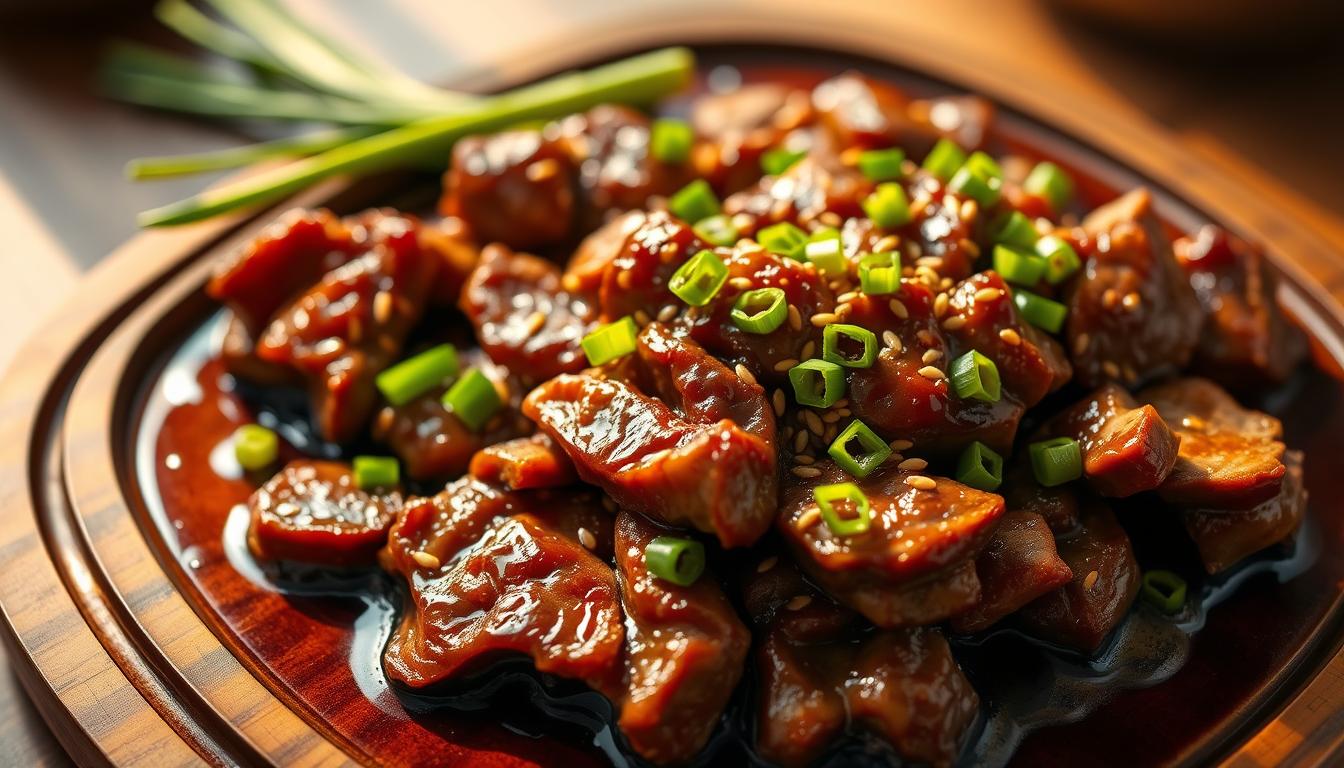Imagine the sizzle of tender beef strips on a grill, the aroma of sweet and savory marinade filling the air. This is the essence of bulgogi, a traditional Korean BBQ dish that has captured hearts for centuries. Known as “fire meat,” bulgogi is more than just a meal—it’s an experience that brings people together.
Once a luxury reserved for special occasions, modern adaptations make it easy to enjoy homemade bulgogi beef anytime. The key to its irresistible flavor lies in the marinade and the quality of the beef you choose. Cuts like rib eye or top sirloin, known for their tenderness, are ideal for achieving that perfect balance of texture and taste.
With this guide, you’ll learn how to create authentic, restaurant-quality bulgogi in the comfort of your own kitchen. From selecting the right ingredients to mastering cooking techniques, we’ll cover it all. Whether you’re a seasoned cook or just exploring Korean cuisine, this guide is tailored for you.
Introduction to Homemade Bulgogi Beef
Korean BBQ is more than just a meal; it’s a cultural experience. At its heart lies bulgogi, a dish that embodies tradition and flavor. Originating centuries ago, bulgogi was once a luxury, but now it’s accessible to everyone.
Exploring Korean BBQ Traditions
Traditionally, Korean BBQ was a communal affair, fostering togetherness. Bulgogi stands out with its sweet and savory marinade, typically featuring soy sauce. This dish has evolved, blending ancient methods with modern twists for home cooks.
What Makes Bulgogi Unique?
The marinade is key, with soy sauce as its backbone, adding depth. Homemade bulgogi offers convenience without sacrificing flavor. It’s a balance of prep and passion, making each bite a testament to its heritage.
By understanding its roots, you enhance your cooking experience. Bulgogi isn’t just meat; it’s a story of tradition and taste, waiting to be told in your kitchen.
Ingredient Spotlight: Choosing the Perfect Beef and Marinade
When it comes to crafting an exceptional bulgogi recipe, the right ingredients make all the difference. Selecting the perfect beef cut and creating a well-balanced marinade are essential steps that elevate this dish from ordinary to extraordinary.
Selecting the Right Beef Cut
Your choice of beef is crucial. Top sirloin and rib eye are favored for their tenderness and rich flavor. These cuts absorb the marinade beautifully, ensuring every bite is juicy and full of flavor. For the best results, opt for thinly sliced cuts to ensure even cooking.
Essential Marinade Components
The marinade is the heart of bulgogi. A classic blend includes soy sauce, brown sugar, garlic, ginger, and fruits like Asian pear or apple. These ingredients work together to tenderize the meat while balancing sweet, savory, and tangy notes. Fresh green onion adds a vibrant aroma that complements the dish perfectly.
| Ingredient | Role in Marinade |
|---|---|
| Soy Sauce | Provides depth and umami flavor |
| Brown Sugar | Adds sweetness and aids in caramelization |
| Ginger & Garlic | Enhances aroma and tenderizes meat |
| Fruit (Pear/Apples) | Softens texture and adds natural sweetness |
| Green Onion | Contributes fresh, aromatic notes |
As Chef Kim notes, “A great marinade is about harmony. It should enhance the beef without overpowering it.” Experiment with marinating times to find your perfect balance—anywhere from 30 minutes to several hours. Remember, quality ingredients are key to a standout dish.
Techniques for Slicing and Tenderizing
Mastering the techniques of slicing and tenderizing is essential for creating a truly exceptional bulgogi dish. These steps ensure your meat cooks evenly and remains juicy, while also absorbing the marinade’s flavors effectively.
The Art of Thin Slicing
Achieving the perfect slice is crucial. Thinly sliced meat, ideally 2-3mm thick, allows for quick cooking and even marination. To make slicing easier, partially freeze the beef for about 30 minutes. This firms the meat, making it simpler to slice thinly against the grain. Cutting against the grain ensures tenderness, as it aligns the muscle fibers for easier chewing.
| Technique | Benefit |
|---|---|
| Partial Freezing | Makes slicing precise and effortless |
| Slicing Against the Grain | Ensures meat stays tender and juicy |
| Thin Slices (2-3mm) | Allows for quick cooking and even flavor absorption |
Tips for Effective Tenderizing
Tenderizing is where the magic happens. Grated Korean pear or apple adds natural enzymes that break down the meat’s fibers, making it tender without losing flavor. Avoid over-marinating, as it can make the meat mushy. Always use a sharp knife and slice away from your body for safety. Proper marination time (30 minutes to several hours) ensures the meat absorbs flavors without becoming tough.
| Tenderizing Method | Result |
|---|---|
| Grated Fruit | Softens meat naturally |
| Marination Balance | Enhances flavor without toughness |
| Safe Knife Handling | Prevents accidents during slicing |
By mastering these slicing and tenderizing techniques, you’ll achieve a dish that’s both flavorful and tender, just like a professional chef.
Step-by-Step Preparation Process
Preparing homemade bulgogi beef involves a few key steps that ensure flavorful and tender results. Proper marination and vegetable preparation are essential for creating a dish that’s both authentic and delicious.
Proper Meat Marination
Start by blending your marinade ingredients until smooth. Use quality oil and measured brown sugar for balance. Massage the marinade into the meat for about 5 minutes to ensure even coating and flavor infusion. Cover the bowl with plastic wrap and refrigerate for at least 4 hours, preferably overnight. This allows the flavors to deepen and the meat to tenderize. Remember to wear food prep gloves for hygiene and safety.
Preparing Complementary Vegetables
While the meat marinates, prepare your vegetables. Slice onions and carrots thinly and cut green onions into bite-sized pieces. These will accompany the beef during cooking, adding texture and freshness to the dish. Lightly drizzle with oil and season with a pinch of salt to enhance their natural flavors.
| Marination Step | Benefit |
|---|---|
| Blending Ingredients | Ensures a smooth, even marinade |
| Massaging Meat | Enhances flavor absorption |
| Refrigeration | Deepens flavor and tenderizes meat |
“A well-marinated beef is the foundation of a great bulgogi meal. Take your time with this step, and you’ll be rewarded with juicy, flavorful results.”
— Chef Kim
By following these steps carefully, you’ll create a dish that’s both authentic and enjoyable. Remember, patience is key—let the marinade work its magic for the best outcome.
Cooking Methods: Grilling vs. Pan Frying
When it comes to cooking bulgogi, the method you choose can significantly impact the flavor and texture. Grilling and pan-frying are the two most popular techniques, each offering unique benefits.
Grill for Authentic Smoky Flavor
Grilling over charcoal infuses the meat with a rich, smoky flavor that’s hard to replicate. This traditional method brings out the deep, savory notes of the marinade, creating a caramelized crust on the meat. For the best results, preheat the grill to medium-high heat and cook the sirloin strips for 3-4 minutes per side. Always ensure the grill is clean and brush it with oil to prevent sticking.
Pan Frying for Juicy Results
Pan-frying is ideal for retaining the meat’s juiciness. Use a high-quality skillet over medium heat to sear the sirloin strips. Cook for 3-4 minutes per side, allowing the meat to develop a nice crust. This method also works well for cooking vegetables alongside the meat, adding texture and freshness to the dish. Transfer the cooked meat to a bowl and let it rest before serving to lock in the juices.
| Cooking Method | Benefits |
|---|---|
| Grilling | Authentic smoky flavor, caramelized crust |
| Pan Frying | Juicy texture, easy to cook with vegetables |

Both methods require careful attention to temperature and timing to achieve the best results. Whether you prefer the smoky charm of grilling or the convenience of pan-frying, each technique will bring out the full flavor of your homemade bulgogi.
Mastering the Recipe for Delicious Bulgogi Beef
Crafting the perfect bulgogi beef requires attention to detail and a focus on key techniques. The marinade and cooking method are crucial for achieving that signature flavor and texture. Let’s dive into the secrets behind a mouthwatering dish.
Secrets to Achieving the Perfect Caramelization
Caramelization is what gives bulgogi its rich, sweet flavor. To achieve this, cook the meat over high heat for a short time. This technique creates a crispy crust on the outside while keeping the inside juicy. Timing is everything—cook for about 3-4 minutes per side to get the best results.
| Technique | Benefit |
|---|---|
| High Heat | Creates a caramelized crust |
| Short Cooking Time | Preserves juiciness |
| Even Searing | Ensures consistent flavor |
Creating a Flavorful Marinade
A well-crafted marinade is the heart of bulgogi. Combine soy sauce, sugar, garlic, and a touch of fruit like pear or apple. These ingredients balance sweet and savory notes while tenderizing the meat. Let it marinate for at least 2 hours to allow the flavors to meld.
| Ingredient | Role |
|---|---|
| Soy Sauce | Depth and umami |
| Sugar | Sweetness and caramelization |
| Garlic | Aroma and flavor |
Serving Suggestions and Pairings
Once your beef bulgogi is ready, the fun begins! How you present and pair it can elevate the entire dining experience. Let’s explore some creative and traditional ways to serve your homemade Korean BBQ.
Plating with Rice and Fresh Greens
A classic way to enjoy beef bulgogi is with a generous portion of steamed rice. The combination of tender meat and fluffy rice creates a perfect harmony of textures. Add some fresh shredded lettuce or perilla leaves on the side for a refreshing contrast. This simple setup allows the rich flavor of the meat to shine while balancing the meal with wholesome vegetables.
Enhancing with Kimchi and Ssamjang
Korean BBQ isn’t complete without a spicy kick. Serve your beef bulgogi with a side of kimchi for that bold, tangy contrast. For dipping, try using ssamjang, a traditional Korean sauce that complements the smoky notes of the meat. These additions not only enhance the flavor but also create a vibrant, colorful plate that’s visually appealing.

For a fun twist, wrap slices of beef bulgogi in fresh lettuce leaves and dip them in ssamjang. This interactive way of eating makes the meal more engaging and enjoyable. Remember, the key to a great presentation is a clean cut and balanced arrangement of ingredients on the plate. Experiment with different vegetables and sauces to find your perfect combination!
Creative Variations and Meal Prep Tips
Elevate your homemade bulgogi game with these creative twists and practical meal prep ideas. Whether you’re looking to experiment with flavors or streamline your cooking process, these tips will keep your BBQ sessions fresh and exciting.
Adapting Marinade Flavors for Variety
Don’t be afraid to get creative with your marinade. Try swapping the traditional Asian pear with a crisp apple or add a splash of citrus for a zesty twist. For a sweeter profile, increase the brown sugar, or go spicy by adding gochujang for an extra kick.
| Marinade Variation | Flavor Impact |
|---|---|
| Spicy Gochujang | Adds a bold, spicy note |
| Citrus Zest | Introduces a bright, tangy flavor |
| Herbs | Infuses fresh, aromatic notes |
Experiment with different ingredients to find your perfect balance. Remember, the marinade is your canvas—paint it with flavors that excite your palate!
Meal Prep Strategies for Success
Prep like a pro! Slice your beef thinly and store it in an airtight container with the marinade for up to 24 hours. Portioning allows for quick, fresh meals throughout the week. Batch-cook and store in the fridge or freezer for later use.
- Portion control for convenience
- Batch-cooking for efficiency
- Freezer storage for up to 3 months
By mastering these variations and prep tips, you’ll keep your bulgogi exciting and stress-free. Share your creations and enjoy the culinary adventure!
Storing and Reheating Your Bulgogi Beef
Proper storage and reheating techniques are crucial to maintain the flavor and texture of your homemade bulgogi beef. Whether you’re refrigerating or freezing, following the right steps ensures your dish remains fresh and delicious.
Proper Refrigeration Techniques
For short-term storage, place the marinated or cooked beef in an airtight container. This prevents air exposure and keeps the meat fresh. Store it in the refrigerator at a temperature below 40°F (4°C). Cooked beef can be kept for up to 4 days, while raw marinated beef stays fresh for 3-4 days.
Freezing and Reheating Guidelines
For longer storage, freezing is ideal. Use airtight containers or freezer bags to prevent freezer burn. Frozen beef can be stored for up to 3 months. When you’re ready to eat, thaw the beef overnight in the fridge or thaw it quickly by submerging the container in cold water. To reheat, cook the beef in a pan with a small amount of sesame oil over medium heat until warmed through. You can also add a sprinkle of toasted sesame seeds for extra flavor.
By following these storage and reheating tips, you can enjoy your homemade bulgogi beef whenever you want while preserving its rich, savory flavor and tender texture.
Conclusion
With the insights gathered, it’s clear that crafting homemade bulgogi is both an art and a joy. By selecting top-tier ingredients and mastering essential techniques, you can create a dish that’s nothing short of extraordinary. Whether you’re in the mood for a quick dinner or planning meals for the week, bulgogi offers the perfect blend of convenience and flavor.
Don’t hesitate to explore both grilling and pan-frying methods—each brings its own charm to the table. Pair your dish with traditional sides like kimchi for a bold, tangy contrast that elevates the meal. Plus, storing and reheating leftovers is a breeze, ensuring your creation stays fresh and flavorful for days.
As you embark on this culinary adventure, remember to savor the journey. Share your experiences and creations on social media, and revisit this guide for inspiration. With these tips, you’re well-equipped to craft authentic, mouthwatering bulgogi that delights both family and friends.
FAQ
What type of beef is best for Korean Beef Bulgogi?
How long should I marinate the beef?
Can I substitute soy sauce with another ingredient?
What is the role of sugar in the marinade?
Can I cook Bulgogi without a grill?
How do I store leftover Bulgogi Beef?
Can I make Bulgogi Beef vegetarian?
What sides pair well with Bulgogi Beef?
Can I make the marinade ahead of time?

